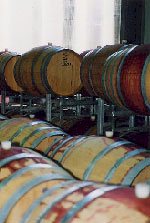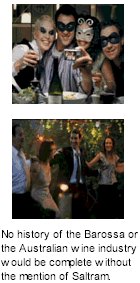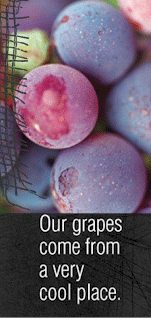| |
|
|

|
Winemaker Don Lewis adores the tannins
Structure And Electrifying Expressions Of Spanish Wine Fruit for Tar & Roses is harvested off elite Heathcote vineyards much of which must be hand picked, all components are treated separately throughout ferments and ageing. The larger volume of Shiraz comes from richer Cambrian soils, while the smaller parcel is grown to much tougher gravelly, grantic soils. The first component makes a rounder, fuller fruit driven wine with intense chocolate and earth characters, the latter contributes elegance and restraint.
|
|
|
|

|
Jacobs Creek are known for their attractive
Medium Bodied Chardonnay A deliciously nectarine flavoured wine highly appealing for it's purity of fruit, elegance and finesse. As the retention of primary varietal characters are the main objective, the ferment is clarified and inoculated to neutral wine yeasts. Post fermentation, components are treated to a rich, extended lees contact and a touch of malolactic which adds complexity.
|
|
|
|

|
Montespertoli lies to the southwest of Florence
Between The Valleys Of Pesa And d'Elsa A range of sloping hills in an open and sun filled countryside where cypress trees sway in the breeze, ploughed fields are defined by woodlands and olive groves, which yield a golden oil that enriches local cuisine. Sangiovese grapes are vinified by Fattorie Parri to a mix of modern and traditional techniques, into a complex and elegant wine, intense with perfume and supported by sound palate structure.
|
|

EXCELLENT LANGTONS CLASSIFICATION. The Dalwhinnie vineyard is situated on the 37th parallel, within a unique amphitheatre which has its own unique mesoclime. The poor fragile soils left over from alluvial mining projects in the early 1800s are some of the hardest and hungriest anywhere. The first Shiraz vines, planted to the Grand Piano Block, were rootlings from the eminent Sunraysia Nurseries at Mildura. The site is totally frost free and harvests achieve complete physiological ripeness nine out of ten years, all vintage releases must surpass expectations.

THE INAUGURAL VINTAGE UNDER THE TAYLOR LABEL WAS IN 1973, it was Cabernet Sauvignon and it wooed the industry, winning gold medals at every national wine show. The Cabernet rich classics of Bordeaux had long held a fascination for the Taylor brothers. Producing wines of comparable quality within Australia prompted the family's foray into the industry. With this vision in mind, the Taylor site was chosen for it's idyllic red brown loams over limestone, its precious Terra rosa soils and splendid Clare Valley clime, renowned for the remarkable quality of Cabernet Sauvignon.

DAMIEN TSCHARKE, proprietor, grower and winemaker is a sixth generation vigneron and Roseworthy baccalaureate who graduated with honours in viticulture. Girl Talk Savagnin is vinified from Albarino, an Iberian varietal that's native to the cool, windswept corner of northwest Portugal and Spain. Thick skinned, naturally acidic and an early ripening aromatic style, Damien Tscharke was convinced it would perform well at in the soils of Marananga. Girl Talk Albarino makes the perfect conversation starter, as well as being a deeply engaging food wine.

A SPECIAL WINE FROM SPECIAL PLACES, mature vines yielding harvests of fruit endowed with complexity and great depth of flavour are the key criteria for inclusion into this limited release Barossa Shiraz. Richmond Grove adhere to a straight forward philosophy of sourcing rich, powerful wines from exceptional vineyards and maturing them under the highest quality oak. A splendid Shiraz of unmistakable regional character and charm, lined with swiss cocolate tannins and brimming with a halo of bright Barossa fruit, a wine of complexity, structure and grace.
|
Down at the
southern tip of Western Australia, between Margaret River and Mt Barker lies the little town of Manjimup and a very large and beautiful Chestnut Tree
The Chestnut Tree is at the highest and most visible site of the Chestnut Grove vineyards. It was always going to be the focal point of the winery that today produces one of the best Merlots in the country, as well as West Australia's finest example of Verdelho.

Every release under the Chestnut Grove label is made fromestate grown fruit, the quality of the wines is a direct reflection of the quality of our vineyards. As the Chestnut Grove vines continue to mature, the wine improves dramatically. The natural balance maintained in the vineyard is evident in the wines, delicious on release, with the ability to age with grace.
Chestnut Grove is rapidly gaining an enviable repute for their world class wines, and created quite a stir when they took out the Most Successful Exhibitor award at the 2006 RSM Bird Cameron Timber Towns Regional Wine Show, winning three Silver and three Bronze Medals.
Freycinet Vineyard is
situated on Tasmania's sunny East Coast, approximately halfway between Launceston and Hobart. This artisinal boutique estate produces the finest, cool climate wines
Freycinet Vineyard overlooks the spectacular Freycinet National Park area that includes the tiny holiday resort of Coles Bay and the world renowned Freycinet Peninsula. Situated on the 42° latitudinal line, Freycinet has a unique microclimate.

The long growing season, which extends into May, combines high sunshine hours with 1250 heat degree days, winter rains with no frost, to produce excellent quality cool climate fruit. The vineyard is a hundred metres above sea level and lies just twenty kilometres from the coast, being very much under maritime influence.
Inspired by the tremendous opportunities along the East Coast, Geoff and Susie Bull established Freycinet Vineyard in 1980. They were early pioneers in a new region which years later revealed exciting potential for the highest quality wines. The region now boasts over a dozen vineyards.
Daughter Lindy Bull and winemaker/ partner Claudio Radenti have taken over the family tradition of gently handcrafting the wines. Lindy and Claudio are passionate about their nine hectare vineyard and are extremely focused on maintaining quality.
The philosophy around Freycinet is to keep things simple, thereby allowing the vineyard to express itself without extra winemaking influence. The aim is to make the wines as big and as beautiful as possible. At harvest the fully ripened fruit has maximum flavour, which is very carefully retained throughout the winemaking process via a gentle and minimalist handling.
The techniques of barrel fermentation and lees stirring, maloactic fermentation and rote fermenters are utilised to produce wines of exceptional colour and flavour. Extended maturation in tight grain French oak casks for twelve to eighteen months completes the winemaking process. Radenti Champagne is crafted to methode traditionelle, an assemblage of Chardonnay and Pinot Noir, reflecting the idyllic conditions of Tasmania's cooler climates in the production of premium sparkling wines.
In 1844 a
recently arrived immigrant from England named William Salter was one of the first people to purchase land in the newly opened land survey known as the Barossa Valley
He built a stone house for his family naming it Mamre Brook, after Abrahams spiritual home in the book of Genesis. Mamre Brook House still stands today as the spiritual home of Saltram. William Salter and Sons first planted grapes here in 1859, and in 1862 produced 8000 litres of a wine appropriately named No.1 Shiraz. In the history of Saltram there have only been eight senior winemakers, two families dominate the list, Salter and Dolan. Three generations of Salters made wine until 1937, and the Dolan's have played a part at Saltram from the 1950s through until today.

The Barossa Valley is actually a long plain that sits at an average of 230m elevation, with small hills on the western side and the steeper Barossa Hills leading toward the higher Eden Valley on the east. The region includes the towns Nuriootpa, Tanunda, and Angaston. Saltram is situated on Nuriootpa Road just a kilometre from the town of Angaston. The soils of the Barossa are predominantly red brown loams, which are non-cracking, well structured and relatively free draining - making them ideal for growing grapevines.
Saltram draws fruit from its own 45 hectare Saltram Vineyard that surrounds the Saltram Winery and Cellar Door as well as from other vineyards throughout the region. These vineyards are spread over from the cooler hills of the Eden Valley to the warmer areas across the valley floor. The Saltram Vineyards yield many different varietals, the vast majority are planted to Shiraz, Merlot and Cabernet Sauvignon, alongside some smaller plantings of non-mainstream varieties such as Malbec, Petit Verdot, Barbera, Nebbiolo and Sangiovese.
Peter Lehmann, while winemaker at Saltram, lightened the traditional styles and made distinctive reds, and fine ports. He encouraged the planting of cabernet sauvignon, harvested earlier for better pH control and introduced new oak casks
Most of the Saltram vines are irrigated via drip irrigation and supported on a variety of trellising systems with more recent planting on single wire trellising and t-trellising systems. Drip irrigation was developed in the 1950s to allow viticulturalists to grow grapevines in climates with low rainfall.
The Barossa Valley receives moderate rainfall of approximately 520mm (mostly falling during the winter months), and has high summer evaporation and low relative humidity. This ideal climate produces relatively low disease pressure, which limits the need for chemicals in the vineyard and also maintains the natural environment. Today, vineyards with a range of climatic conditions use drip irrigation as it allows them more control over the amount of water the vines receive. This extra control allows them to stress the vine by not irrigating at certain times, and irrigating it at others in order to control the crop level and quality of grapes the vine produces.
The Saltram Vineyards also have a number of older vines that were planted in the 1950s and 1960s that are dry grown - not irrigated at all. Dry growing the grapes on these vines produces more concentrated flavours and a higher skin to pulp ratio which improves wine colour and tannin levels. In good years, select parcels from theses vines go into the renowned Saltram No.1 Shiraz and various other special blends that make up Saltrams superb range of wines.
Unlike many wineries,
the history of Starvedog Lane isn’t linked to some long dead legendary winemaker who was the son of someone rich or famous
There are no tales of bravery and courage, and no triumph of the pioneering human spirit. Of suffering and loss, but ultimate victory in the face of adversity all in the interest of bringing you a great drop of wine. Nope. Just a name that comes from some old story about a hungry dog and some German settlers and a bunch of winemakers who are pretty fanatical about what they do. So what Starvedog Lane lack in a colourful and eventful history, they more than make up for with some sensational wines. And at the end of the day, that’s what it’s all about, right?

As winemakers, it goes without saying grapes are pretty important. Starvedog Lane's come from a little place called the Adelaide Hills region. It’s called that because it’s near Adelaide. And there are plenty of hills. So while it’s not the most imaginatively named region, it has become highly regarded as one of Australia’s best cool climate grape growing regions.
The region itself stretches from Clarendon to McLaren Vale, up to Eden Valley and the start of the Barossa district so there’s a fair bit of it. More than enough, in fact, to give all the wonderful grapes needed to make equally wonderful wines. Some people get a bit nervous when you use a phrase like ‘fresh cut grass’ to describe the flavour of a wine. Unless you’re a cow, terms like this are hardly likely to get your tail wagging. But honestly, don’t let it put you off or else you’ll be missing out on a real treat. If you’ve got something to celebrate, Starvedog Lane is the puppy to do it with. If you haven’t got anything to celebrate, don’t worry, when you’ve got one of these handy you can always celebrate having a damn fine wine to drink.
Starvedog Lane uses many grape types, but it’s certainly no mongrel – quite the opposite in fact. It’s the combination of styles that gives Starvedog Lane it's characteristics, but plenty of the kind of flavour that makes a wine really good. Starvedog Lane goes sensationally well with anything, as aperitifs, with seafood, pasta dishes and the word ‘darling’.
Chardonnay is what many people refer to as The King of white grapes and is one of the most popular white wines going around. If you want a white, and you’re not sure what to get, this is a pretty good way to go. Keep in mind it’s no lightweight though – as far as white go, it’s got more body than most. Unlike their No Oak Chardonnay this one’s gotten rather friendly with French oak so has that classic hint of spicy oak in it. It’s a fine wine with real character, and if you’re thinking of tucking into something like antipasto, scallops, creamy pasta, chicken or even a Thai laksa, this drop is definitely one to savour along with your meal.
Starvedog Lane also makes unwooded wine with the same style of grapes as their regular Chardonnay, but this one’s steered clear of the French connection. While it’s never snuggled up to any French oak, it’s in great company if there’s fish and chips or creamy pasta on the menu. It’s a little lighter than traditional Chardonnay and has plenty of spicy, fruity, flavour without being at all sweet. Paul, the winemaker behind this one, uses words like ‘zest’ and ‘racy’ when he talks about it and says it’s particularly good sitting on ice – we can only imagine he means the wine, not you.
|